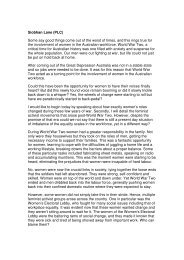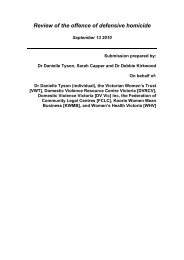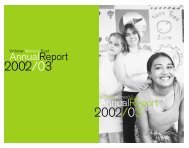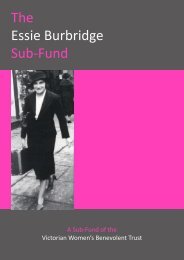entire document here - The Victorian Women's Trust
entire document here - The Victorian Women's Trust
entire document here - The Victorian Women's Trust
You also want an ePaper? Increase the reach of your titles
YUMPU automatically turns print PDFs into web optimized ePapers that Google loves.
INTRODUCTIONour water markUnderstanding this bigger picture better places us toscope the things we can all do. It helps us to identifythe important principles we ought to work by and ithelps us find points of entry into debates about water.It prompts us to initiate actions to make a real differencein our households, local communities and institutions,and on our farms. On another level, we can play astronger role in shaping how our political institutionsrespond to this crisis.OF PEOPLE, BY PEOPLE, FOR PEOPLEOver a decade ago, the 1992 Dublin Water and the EnvironmentConference identified four principles that have became knownas the Dublin Principles. <strong>The</strong> first states that ‘water is a finite,vulnerable and essential resource that should be managed inan integrated manner.’ <strong>The</strong> third states that ‘women play a centralrole in the provision, management and safeguarding of water.’ 1In 2000, the <strong>Victorian</strong> Women’s <strong>Trust</strong>, intuitively recognisingthis third principle, designed a community-based initiative togive people a greater knowledge of water issues and a strongerfoothold in debates and discussions about water. <strong>The</strong> initiativefollowed in the footsteps of an earlier project, the Purple SageProject. We named it the Watermark Australia Project.We put our faith in the leadership capacity of women to helpmake this project a reality. This faith was rewarded in spades.Aside from <strong>The</strong> Myer Foundation, the private donors who madethe whole thing possible were mainly women. Most of the groupleaders who brought together the discussion groups acrossVictoria and interstate were also women, and the project teamwithin the office of the Women’s <strong>Trust</strong> was comprised largelyof women.Through 2004 and 2006, the <strong>Trust</strong> developed a set of innovativelearning materials about water and a Watermark website. We setup a simple process w<strong>here</strong>by ordinary men and women, fromall over Australia, could come together in small groups to discussthese materials and determine what they might do in response.Twice in this process, these volunteer Watermark groups(representing several thousand people) gave us reports thatsummarised their valuable conversations, their questions andtheir independent ideas about water. Many other people contactedus by phone and email to share their thoughts and experienceswith water. At key points, we merged these reports and otherinputs with our own thinking and with the experiences and thetechnical knowledge of a group of eminent scientists who gaveus their time because they, too, saw an urgent need to mobilisethe community around the water issue.This <strong>document</strong>, Our Water Mark: Australians makinga difference in water reform, is the culmination of allthis labour.It respects and builds on the wisdom and experience of thepeople who came together in Watermark groups, it draws outthe consensus that emerged across these groups, and it combinesthis with scientific knowledge and technical data to providea constructive framework for people everyw<strong>here</strong> to think about,and act on, water reform.ABOUT THIS DOCUMENTEverything in this <strong>document</strong>, has been compiled with one aim inmind: to provide people in the broader community with a credibleand accessible source of information about water. We hope thatit will be read by all and sundry, talked about around the kitchentable and used as a spur for bringing about positive change in theway our society uses and manages water.In compiling this <strong>document</strong> we have striven to use key reports andinformation that have been in the public domain for some time.However, while we all rely on these sources, the overall picture ofwater in Australia remains patchy because we still lack systematic,national data on key aspects of water measurement and use.For practical purposes, every section of this <strong>document</strong> is writtenand formatted as a stand-alone piece. This is to allow individuals,families or other groups who want to read and talk aboutparticular issues (e.g. surface water or groundwater) to selectthe relevant part in ‘<strong>The</strong> Big Picture’. <strong>The</strong> particular section canthen be photocopied, read and talked about.Similarly, people who want to focus on the goal and principlesor a relevant action section (such as what people in householdsor on the land can do), can select the relevant sections andreproduce these as a basis for discussion or action.All text references are supplied so that you can access thesources used if you want to do further reading. We also includesome additional references to encourage you to explore areasof interest further. A glossary is provided at the back of the<strong>document</strong> to help explain unfamiliar terms.Towards the end of the <strong>document</strong> we outline a process w<strong>here</strong>byyou can endorse Our Water Mark and sign on as a public gestureof your commitment to take action, share your experiences andhasten the necessary community momentum around water.If you want to assess the credentials and bona fides of theoriginating project, Watermark Australia, and access any ofthe supporting <strong>document</strong>ation, this information can be foundon the project website:.REFERENCEsP van der Zaag & HHG Savenije,1. Water as an economic good:the value of pricing and the failure of markets, UNESCO-IHEInstitute for Water Education, Value of Water Research ReportSeries No. 19, Delft, <strong>The</strong> Netherlands, 2006, p. 14.<strong>Victorian</strong> Women’s <strong>Trust</strong> - Our Water Mark 9






